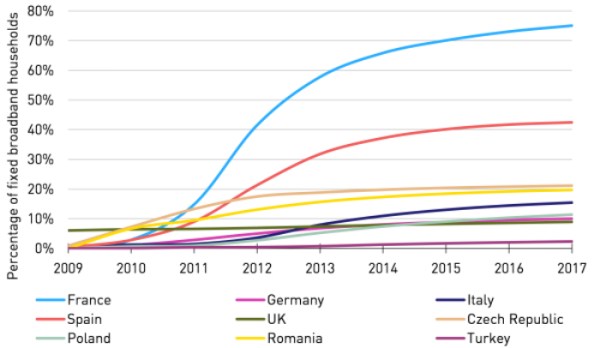Pump and signal combiner for bi-directional pumping of all-fiber lasers and amplifiers(6)
4.4 Experimental results
In order to verify the simulations, two fiber combiners with a single pump port based on the setup described in Section 2 were developed. For the first combiner an IF with a low TR of 2.6 and a short TL of 9.5 mm was fabricated. In the case of the second combiner the TR and the TL were increased to 6.7 and 18 mm, respectively. For both combiners the geometrical dimensions of the obtained tapered IFs were measured with an optical microscope. After completion of the fabrication, both combiners were optically characterized. Therefore, each PFF (pump port) with a NA of 0.15 was connected to a pump diode (Oclaro BMU25) with a pigtail fiber delivering a maximum output power of ~25 W at a wavelength of 976 nm. The delivery fiber of the pump diode had parameters identical to the PFF.
The experimental results for the first fiber combiner are shown in Fig. 6(a)

Fig. 6 Coupled and transmitted power measured for a fiber combiner with one pump port with (a) a TL of 9.5 mm (TR of 2.6) and (b) a TL of 18 mm (TR 6.7), * ratio of coupled or transmitted power to total diode power in percent.
. Due to the low TR of 2.6, an experimental pump coupling efficiency of only 74% was achieved. The residual pump power was almost completely measured as TP, with a power fraction of 25.3%. The simulations for the coupled as well as the TP show good agreement with the experimental results, and confirm that in the case of a low TR of 2.6, the pump power is only divided into coupled power and TP. In Fig. 6(a) it can be seen that in the simulations the sum of the coupled and TP is 99.9%, corresponding to 0.1% of pump light rays not detected in the simulations. This can be treated as a simulation error. That the measured sum of coupled pump power and TP is only 99.3% can be explained by measurement uncertainties, marginal splice losses and additional power losses in the fiber component caused by dust particles. Since the thermal load of this fiber combiner design is negligible it would be feasible to couple several kW of pump power, but with the disadvantage of a moderate coupling efficiency of about 75% and consequently a undesirable overall efficiency for high power laser system.
For the second fiber combiner, depicted in Fig. 6(b), a higher pump coupling efficiency of 95.2% (96.0% in simulation) was measured as compared to the first combiner presented in Fig. 6(a) due to the increase in TR and TL. Following the simulations the residual pump power of 4% can be divided into TP, PCT and PAA with 2.4%, 0.6% and 0.9%, respectively. Again, the missing pump power of 0.1% was associated with an error owing to undetected power in the simulations. For the TP a fraction of 2.3% was measured and shows very good agreement with the simulation (2.4%), i.e. more than 50% of the total power loss was TP. This fraction of power represents no risk for damage to the fiber component. Due to the excellent agreement between simulation and experiment, the simulated PCT-fraction of only 0.6% is a good value for an estimate of the thermal load of the coating of the TF. Based on the simulations and experiments an error of less than 1% of the pump input power can be assumed for the PCT-fraction.
Unfortunately, the power fractions PAA and PCT are difficult to measure and therefore could not be experimentally determined. In future work an indirect measurement of PCT will be realized by measuring the coating temperature of the CWDM Module. In summary, the simulations describe the coupling efficiency as well as the fraction of TP very well, and thus, serve as a very good estimation for the fraction of PCT and PAA.
DK Photonics – www.dkphotonics.com specializes in designing and manufacturing of high quality optical passive components mainly for telecommunication, fiber sensor and fiber laser applications,such as PLC Splitter, WDM, FWDM, CWDM, DWDM, OADM,Optical Circulator, Isolator, PM Circulator, PM Isolator, Fused Coupler, Fused WDM, Collimator, Optical Switch and Polarization Maintaining Components, Pump Combiner, High power isolator, Patch Cord and all kinds of connectors.



